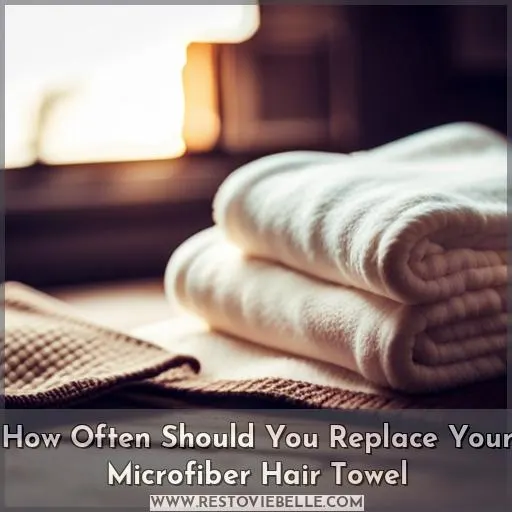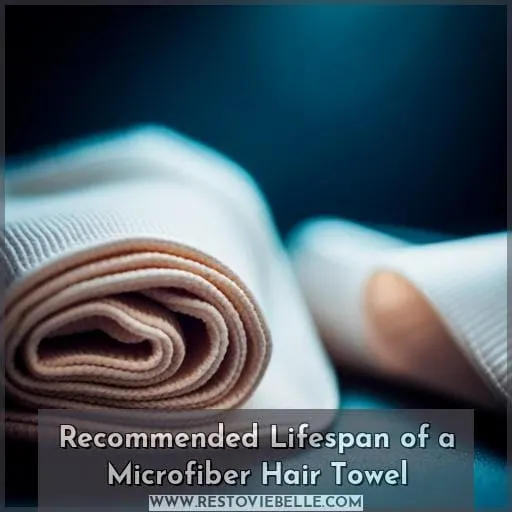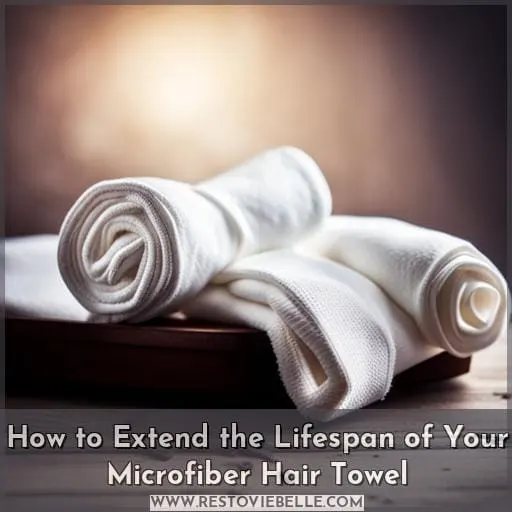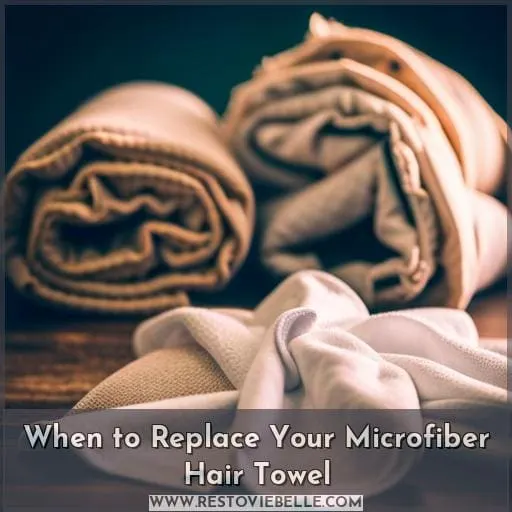This site is supported by our readers. We may earn a commission, at no cost to you, if you purchase through links.
 Imagining yourself wrapped in a luxurious microfiber hair towel after a shower, you can’t help but wonder how often you should replace it. Well, fret not! In this article, we will provide you with all the information and guidance needed to determine when it’s time for a new one.
Imagining yourself wrapped in a luxurious microfiber hair towel after a shower, you can’t help but wonder how often you should replace it. Well, fret not! In this article, we will provide you with all the information and guidance needed to determine when it’s time for a new one.
From signs of wear and tear to factors that affect its lifespan, we’ve got you covered.
Table Of Contents
- Key Takeaways
- Signs of Wear and Tear
- Recommended Lifespan of a Microfiber Hair Towel
- How to Extend the Lifespan of Your Microfiber Hair Towel
- When to Replace Your Microfiber Hair Towel
- Signs of Bacterial Growth or Odor
- Importance of Regular Assessment and Replacement
- Frequently Asked Questions (FAQs)
- Can I use my microfiber hair towel for purposes other than drying my hair?
- Are there any specific signs to look for to determine if my microfiber hair towel needs to be replaced?
- Can I repair any damages or tears on my microfiber hair towel?
- Is it safe to use a microfiber hair towel on all hair types?
- How can I properly store my microfiber hair towel to extend its lifespan?
- Conclusion
Key Takeaways
- Fraying or unraveling edges and loss of absorbency are signs of wear and tear in microfiber hair towels.
- The recommended lifespan for a microfiber hair towel is generally 6-12 months, depending on factors such as frequency of use, care, and quality.
- Factors that affect the lifespan of microfiber hair towels include maintenance and hygiene standards, replacement frequency, and the quality of the towel.
- To extend the lifespan of a microfiber hair towel, proper washing and drying techniques should be followed, including handwashing with gentle detergent or using a delicate cycle in a washing machine, proper folding and quick drying, and avoiding abrasive materials.
Signs of Wear and Tear
As you continue to use your microfiber hair towel, it’s important to be aware of signs of wear and tear that may indicate the need for a replacement.
One common sign is fraying or unraveling edges, which can affect the towel’s performance and durability.
Another indicator is a loss of absorbency, where the towel no longer effectively soaks up moisture from your hair.
Lastly, stains or discoloration on the towel may suggest that it has reached its lifespan and should be replaced for hygienic reasons.
Fraying or Unraveling Edges
If you notice frayed or unraveling edges on your microfiber hair towel, it’s time to consider replacing it.
Frayed edges can compromise the effectiveness and lifespan of the towel.
To ensure optimal absorbency, prevent stains, and maintain hygiene vigilance, regular care instructions should be followed for edge maintenance and overall towel replacement.
Loss of Absorbency
When your microfiber hair towel starts to lose its absorbency, it’s time to consider replacing it.
Loss of absorbency can be a sign of wear and tear, affecting the effectiveness of the towel in drying your hair.
To maintain optimal moisture absorption and prevent hygral fatigue, regularly assess the absorbency level of your microfiber hair towel and replace as needed for healthier, more manageable hair.
Stains or Discoloration
You’ll know it’s time to replace your microfiber hair towel when you notice stains or discoloration.
Stains can occur due to various factors such as hair products, oil buildup, or even dye transfer from colored hair.
To prevent staining, avoid using harsh products on your hair and refrain from drying off with a towel immediately after applying any treatments.
If you do encounter stains, try DIY solutions like vinegar or baking soda mixed with water for stain removal.
Additionally, regularly refreshing the fabric of your microfiber towel through proper washing techniques can help maintain its appearance and longevity.
Recommended Lifespan of a Microfiber Hair Towel
When it comes to the recommended lifespan of a microfiber hair towel, a general guideline is to replace it every 6-12 months.
Factors such as:
- Frequency of use
- Proper care and maintenance
- Quality of the towel itself
- Signs of wear and tear
should be considered when determining if it’s time for a replacement.
General Guideline for Replacement
To determine the ideal time to replace your microfiber hair towel, it’s important to consider its recommended lifespan.
The frequency of replacement depends on several factors such as wear indicators, hygiene standards, and bacterial concerns.
Pay attention to signs of wear and tear like fraying edges or loss of absorbency.
Proper washing techniques and air drying can help prolong the lifespan of your towel.
Regular assessment is crucial for maintaining optimal hair health and preventing potential damage or skin issues caused by an old or unhygienic towel with high porosity.
Factors That May Affect Lifespan
To maximize the longevity of your microfiber hair towel, consider various factors that can impact its lifespan.
Factors such as maintenance, hygiene standards, replacement frequency, and bacterial signs play a significant role in determining how long your towel will last.
Proper maintenance includes washing the towel regularly in a washing machine with mild detergent and avoiding abrasive materials or high heat during drying.
Following these guidelines will ensure that your microfiber hair towel stays fresh and effective for an extended period of time.
How to Extend the Lifespan of Your Microfiber Hair Towel
To extend the lifespan of your microfiber hair towel, it’s essential to follow proper washing and drying techniques.
Handwashing with a gentle detergent or using a washing machine on a delicate cycle can help maintain the integrity of the delicate fibers.
Additionally, storing and handling your towel properly by avoiding abrasive materials and allowing it to dry completely can also contribute to its longevity.
Proper Washing and Drying Techniques
To extend the lifespan of your microfiber hair towel, it’s important to follow proper washing and drying techniques.
When washing by hand, create a soapy solution using water and a clear liquid detergent or specialized cleaning solution.
Opt for air drying by hanging the towel on a clothesline for natural drying benefits.
Machine washing requires separating towels from lint traps and using gentle cycles with low-heat settings to prevent damage to delicate fibers.
Storing and Handling Tips
To extend the lifespan of your microfiber hair towel, it’s important to properly store and handle it.
Here are some tips for storing and handling your microfiber hair towel:
- Proper Folding:
- Fold the towel neatly after each use to prevent wrinkles and maintain its shape.
- Ensure that the towel is completely dry before storing it to avoid moisture buildup, which can lead to mold or mildew.
- Hang the towel in a well-ventilated area using a secure hook or loop to promote airflow and prevent dust and dirt buildup.
By following these storing and handling tips, you can prolong the life of your microfiber hair towel while keeping it clean and fresh for optimal use.
When to Replace Your Microfiber Hair Towel
Knowing when to replace your microfiber hair towel is important for maintaining its effectiveness and ensuring personal hygiene. Factors such as frequency of use, overall condition, and cleanliness standards play a role in determining when it’s time for a replacement.
By understanding these factors and following recommended guidelines, you can make an informed decision about replacing your microfiber hair towel to ensure optimal results.
Frequency of Use
You should consider replacing your microfiber hair towel after a certain number of uses and when it starts to show signs of wear.
The frequency of use will depend on factors such as how often you wash your hair and the specific care instructions for your towel. Generally, washing the towel after every three uses is recommended to prevent dirt buildup and bacterial growth.
Proper drying techniques, such as air drying or using low heat in the dryer, can also help prolong its lifespan. Additionally, storing the towel in a clean and dry environment will minimize potential damage from moisture or other elements that could affect its effectiveness in your beauty routine.
Personal Hygiene and Cleanliness Standards
If you notice any signs of bacterial growth or odor, it’s time to replace your microfiber hair towel.
Personal hygiene and cleanliness standards are crucial when it comes to using a hair towel.
To prevent the buildup of bacteria and maintain optimal hygiene, wash your microfiber hair towel after every three uses.
Additionally, ensure that the towel stays dry when not in use by utilizing proper storage solutions.
Following these practices will help keep your hair healthy and clean while extending the lifespan of your microfiber hair towel.
Signs of Bacterial Growth or Odor
If you notice a foul smell even after washing your microfiber hair towel, it may be a sign of bacterial growth.
Bacteria can thrive in the damp environment of the towel, leading to odor and potential hygiene issues.
Lingering dampness or moisture on the towel is another indicator that bacteria may be present.
Foul Smell Even After Washing
If your microfiber hair towel has a foul smell even after washing, it may be a sign of bacterial growth or odor.
- Use warm water: Wash your microfiber hair towel in warm water to help remove bacteria and eliminate the source of the foul odor.
- Refreshing towel techniques: Soak the towel in a mixture of vinegar and water for 15-30 minutes before washing to neutralize any remaining smells.
- Smell prevention tips: Allow your microfiber hair towel to fully dry between uses, as moisture can lead to bacterial growth and unpleasant odors.
By following these steps, you can keep your microfiber hair towels smelling fresh and free from bacteria-related issues.
Lingering Dampness or Moisture
If you frequently notice lingering dampness or moisture in your microfiber hair towel, it may be a sign of bacterial growth or odor.
Ensuring proper moisture management is essential to prevent microbial risks and maintain the drying efficiency of your towel.
Lingering dampness can indicate reduced absorbency and compromised hygiene.
To address this issue, consider assessing the longevity of your microfiber hair towel and replacing it if necessary to avoid unpleasant odors and potential skin issues caused by bacteria buildup.
Importance of Regular Assessment and Replacement
Regular assessment and replacement of your microfiber hair towel is crucial for maintaining optimal hair health and hygiene.
Over time, these towels can accumulate dirt, oils, bacteria, and germs that can lead to potential skin issues.
By regularly assessing the condition of your towel and replacing it when necessary, you ensure that it continues to effectively absorb moisture from your hair without causing any damage or compromising its hygienic properties.
Maintaining Optimal Hair Health and Hygiene
Regularly assess and replace your microfiber hair towel to maintain optimal hair health and hygiene.
While microfiber towels offer numerous benefits, it’s important to ensure they’re in good condition for effective use.
Consider alternatives such as cotton towels if you prefer a different material.
Implement DIY towel care techniques like handwashing with cool water and mild detergent or using a washing machine on gentle cycle with low heat drying settings.
Following these tips will help keep your hair healthy and promote quick-drying techniques.
Preventing Damage and Potential Skin Issues
To prevent damage and potential skin issues, regularly assess your microfiber hair towel to ensure its effectiveness.
Proper assessment techniques can help identify signs of wear and tear, such as:
- Fraying edges
- Loss of absorbency
- Stains or discoloration
By being proactive in assessing the condition of your towel, you can address any issues before they become problematic. This not only helps maintain optimal hair health but also promotes good hygiene practices by preventing bacterial growth or skin irritation caused by a worn-out or unclean towel.
Frequently Asked Questions (FAQs)
Can I use my microfiber hair towel for purposes other than drying my hair?
Yes, you can certainly use your microfiber hair towel for purposes other than drying your hair.
It can be used to:
- Clean surfaces
- Remove makeup
- Even as a gym towel.
Its versatility makes it a valuable tool in your daily routine.
Are there any specific signs to look for to determine if my microfiber hair towel needs to be replaced?
To determine if your microfiber hair towel needs replacement, look for signs of decreased effectiveness in drying and absorbing moisture.
If it no longer performs as well as before, it’s time to consider getting a new one for optimal results.
Can I repair any damages or tears on my microfiber hair towel?
To repair damages or tears on your microfiber hair towel, you can try using a needle and thread to mend the fabric carefully.
Ensure that the repaired area is secure to maintain its effectiveness and prolong its lifespan.
Is it safe to use a microfiber hair towel on all hair types?
A microfiber hair towel is safe for all hair types, providing quick-drying and reducing frizz.
Its gentle material prevents hygral fatigue, promoting healthy and strong strands.
Experience the convenience and effectiveness of a microfiber hair towel today for your specific needs.
How can I properly store my microfiber hair towel to extend its lifespan?
To properly store your microfiber hair towel and extend its lifespan,
- Hang it in a well-ventilated area to ensure thorough drying.
- Avoid storing it in damp or humid conditions that could lead to mold or mildew growth.
Conclusion
To ensure your hair towel game is on point, it’s important to know when to replace your microfiber hair towel.
Signs of wear and tear, such as fraying edges or loss of absorbency, indicate it may be time for a new one.
The recommended lifespan of a microfiber hair towel varies, but factors like proper washing and drying techniques and storing tips can help extend its lifespan.
Regular assessment and replacement are crucial for maintaining optimal hair health and preventing potential skin issues. So, keep an eye out for signs of bacterial growth or odor, and replace your towel as needed to ensure cleanliness and hygiene.












